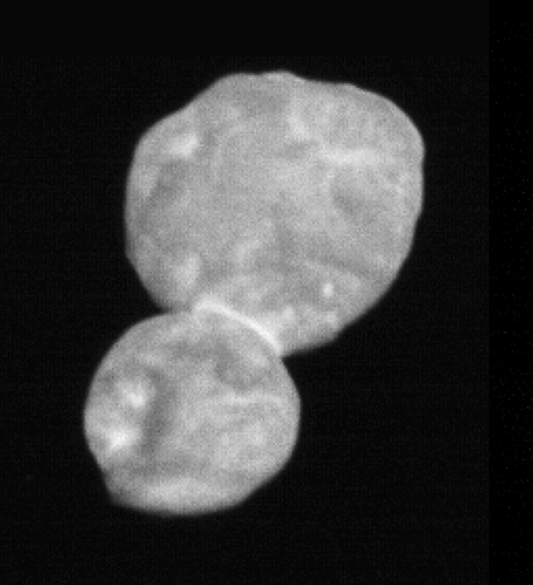Very early on New Year’s Day 2019, NASA’s New Horizons spacecraft encountered its second major mission target — a Kuiper Belt object nicknamed Ultima Thule, after a classical and medieval name for places beyond the furthest known lands. Ultima Thule is truly the furthest known “land” ever visited in the solar system. With a semi-major axis of approximately 45 AU*, it is nearly 50% further from the sun than Neptune and a full 5 AU further than Pluto’s average distance. Ultima Thule is small, only 30 km long, but it is likely to be representative of other primitive objects in the solar system, and so has potential to resolve some long-standing questions about the early solar system. For example, close-up images of Ultima Thule show that it is a contact binary — two separate, mostly spherical objects touching each other. The cores of many comets (like comet Halley) are elongated or bi-lobed, and Ultima Thule could represent the original states of these comets.
Neither of the object’s two lobes, informally named Ultima and Thule, is flattened significantly or broken, which means that they were moving slowly (less than a few miles per hour) when they touched each other. This is much slower than theories predict. Ultima Thule rotates quite slowly, approximately 15 hours per rotation, whereas dynamic models of its formation suggest that Ultima and Thule rotated around each other every four hours when they touched. This difference suggests that Ultima Thule had moons, which could have accommodated the now-lost rotation (i.e., angular momentum). Ultima and Thule are both the same red-brown color, which is consistent with space-weathered ices containing organic compounds. All of these observations are from the first few days of a dataset that will take nearly 20 months to download. Imagine what else that dataset may hold for us as we continue to explore the observations made during the flyby of a distant object in the outer reaches of the solar system!
* An AU is an astronomical unit, the distance from the sun to the Earth.
For more information visit: http://pluto.jhuapl.edu/Ultima/Ultima-Thule.php
